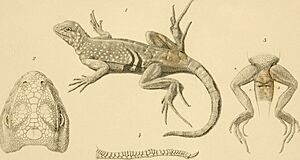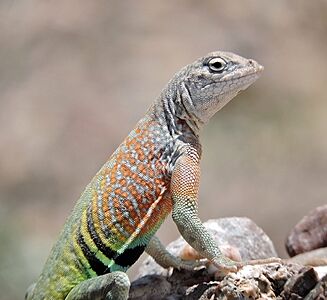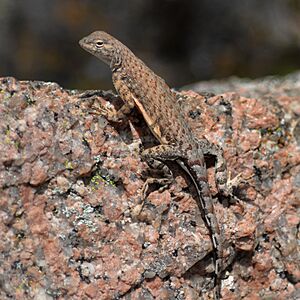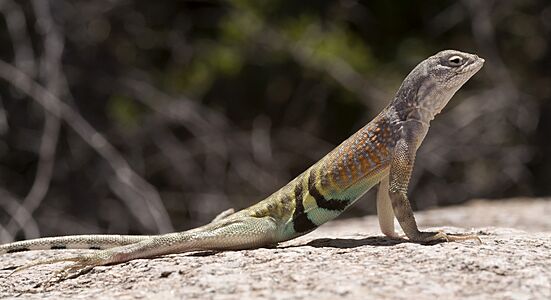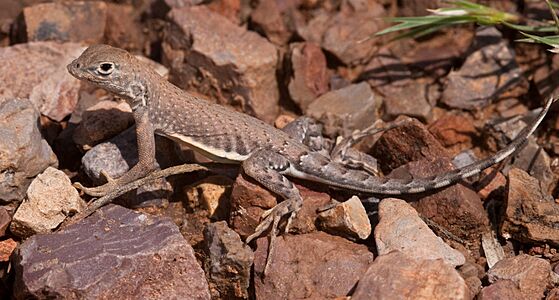Greater earless lizard facts for kids
Quick facts for kids Greater earless lizard |
|
|---|---|
 |
|
| Cophosaurus texanus (male) | |
| Conservation status | |
| Scientific classification | |
| Genus: |
Cophosaurus
|
| Species: |
texanus
|
The greater earless lizard (Cophosaurus texanus) is a fascinating reptile. It's the only species in its group, called Cophosaurus. These lizards are related to other "earless lizards" and are known for not having outside ear openings. This helps them burrow in the sand.
Male greater earless lizards are usually bigger and more colorful than females. They show off bright pink and green colors, especially when it's time to find a mate. Males also have two bold black stripes on their sides. Females might have very faint stripes or none at all.
These lizards live in the Chihuahuan Desert and other dry areas in the Southwestern United States and northern Mexico. They like open spaces with rocks, gravel, and sand. Their skin color often matches the rocks and soil around them, which helps them hide. They use their amazing speed and camouflage to escape from predators.
Greater earless lizards mostly eat insects like crickets, grasshoppers, ants, and beetles. Sometimes, they also eat spiders or even small lizards. Females lay 1 to 4 groups of eggs each year, with 2 to 9 eggs in each group. Baby lizards hatch from June to October and become adults in about a year.
Contents
About the Name of the Earless Lizard
The name Cophosaurus comes from two Greek words. Copho means "deaf," and saurus means "lizard." This name was chosen because these lizards do not have outside ear openings.
The second part of their name, texanus, refers to Texas. This is where the first lizards of this kind were found and studied.
There are also names for different types, or subspecies, of this lizard. Reticulatus means "net-like pattern," and scitulus means "handsome" or "pretty."
Lizard Family Tree: Taxonomy
The greater earless lizard belongs to a family of lizards called Phrynosomatidae. It is closely related to other "sand lizards" like the Zebra-Tailed Lizards and Fringe-Toed Lizards.
Cophosaurus texanus is the only species in its specific group, or genus, called Cophosaurus. A scientist named Franz Hermann Troschel first described this lizard in 1850. For a long time, it was thought to be part of another group called Holbrookia. However, by the 1980s, scientists agreed it should be in its own genus, Cophosaurus.
Today, scientists recognize three main types, or subspecies, of the greater earless lizard:
- Texas greater earless lizard (Cophosaurus texanus texanus)
- Sonoran greater earless lizard (Cophosaurus texanus reticulatus)
- Chihuahuan greater earless lizard (Cophosaurus texanus scitulus)
What the Greater Earless Lizard Looks Like
The greater earless lizard is a medium-sized lizard. It is the largest of the earless lizards. Males can grow up to 18.4 cm (7.25 inches) long. Females are a bit smaller, reaching about 14.3 cm (5.6 inches). These measurements include their head, body, and tail.
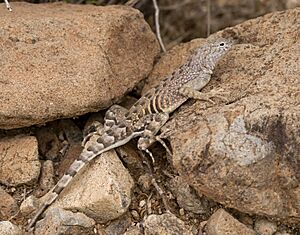
As their name suggests, they do not have outside ear holes. Their scales are small and feel grainy. They have long legs, especially their back legs. Their tail is a bit flat and longer than their head and body combined. The underside of their tail is white with 5 to 9 bold black bands.
Their main body color can be gray, brown, tan, or reddish-brown. This helps them blend in with the rocks and soil where they live.
Males and females look different in their colors and markings. Males have two black bands on their sides, above two blue patches on their belly. The front part of their body often has shades of pink, orange, or red. The back part of their body can be green or lime-green. These colors are brightest during the breeding season. Some people even call them "the lizard with the pink shirt and green pants."
Females usually do not have these black bands, or they are very faint. Young lizards and females often have a white stripe along their sides.
Where Greater Earless Lizards Live
The greater earless lizard lives in the southwestern United States and northern Mexico. You can find them in states like Arizona, New Mexico, and Texas. In Mexico, they live in areas like Chihuahua and Coahuila. They can live at different heights, from low areas to mountains.
The Texas greater earless lizard lives in central Texas and parts of northern Mexico. The Chihuahuan greater earless lizard is found across much of the Chihuahuan Desert. This includes parts of west Texas, New Mexico, and Arizona, as well as several Mexican states.
The Sonoran greater earless lizard lives only in northeastern Sonora, Mexico. It is found in a smaller, specific area.
Life and Habits of the Greater Earless Lizard
Reproduction and Life Cycle
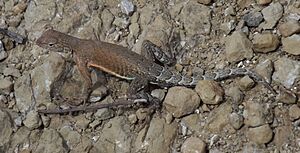
Greater earless lizards usually live for about 3 years. Some have been known to live up to 5 years in the wild. Both males and females become adults and can mate when they are about one year old.
Mating happens from April to August, with the busiest time from late April to early July. Females ready to lay eggs often have pink, orange, or yellow colors on their throats and sides.
Females lay multiple groups of eggs each year, up to four times. Each group can have 2 to 9 eggs, but usually 3 to 5. Older females tend to lay more eggs. The eggs hatch after about 50 days. Baby lizards appear from June to October.
What They Eat: Diet
Greater earless lizards are mostly insect-eaters. They eat a wide variety of insects. Studies show their diet includes many Orthoptera (like crickets and grasshoppers), Hymenoptera (like ants and wasps), and Lepidoptera (like caterpillars). They also eat flies, beetles, and other bugs.
Spiders are also a common food. Sometimes, they even eat small lizards, especially young ones. They usually do not eat plants, or if they do, it's by accident.
These lizards are "sit-and-wait" hunters. They often sit on a high rock or branch in an open area. When an insect passes by, they quickly dash out to catch it. They have even been seen jumping into the air to grab their prey.
Where They Live: Habitat
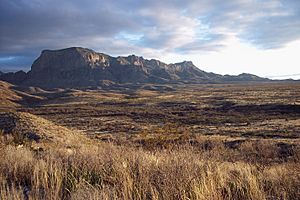
The greater earless lizard lives in dry places like the Chihuahuan Desert. They also live in semi-dry areas in Texas and Arizona.
Within these regions, they prefer open areas with few plants, and lots of rocks and boulders. They like dry riverbeds, canyons, and areas with sand, gravel, and rocks. They can also be found on hills with limestone or granite.
Some plants found where these lizards live include mesquite, creosote bush, and different types of cactus.
The color of a lizard often matches the rocks and soil where it lives. For example, lizards from Llano County, Texas are often rusty brown, like the red granite there. These lizards can be very common in some areas, but completely missing from other places that seem perfect for them.
How They Behave: Behavior
Greater earless lizards are active during the day. They are most active in the late morning and late afternoon, taking a break during the hottest part of the day. They like warm temperatures, usually between 37–41°C (98.6–105.8°F).
At night, they often burrow into loose sand, sometimes as deep as 15 cm (6 inches). If there is no sand, they might bury themselves in gravel or shale. Females have been found buried together under shale on cold winter days.
These lizards mostly stay on the ground. They often find a high spot, like a rock, to look for food and watch for predators. When a predator approaches, they usually run away very fast. They can run from one rock to another, or dash a short distance and then suddenly stop and freeze. Their camouflage helps them disappear. They can even run on two feet for short bursts of speed!
Male, female, and even very young lizards show off their territory. They do this by bobbing their heads, doing "pushups," and flattening their bodies. Another interesting behavior is lifting and curling their tail over their back while running. They wave their striking black and white banded tail in the air. This helps distract predators from their head and body. The tail also helps them balance when running fast. Lizards that have lost their tails run about 32% slower.
Gallery
-
Texas greater earless lizard (Cophosaurus t. texanus), male, Llano County, Texas (26 April 2022)
-
Chihuahuan greater earless lizard (Cophosaurus t. scitulus), male, Doña Ana County, New Mexico, (30 April 2015)



